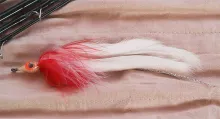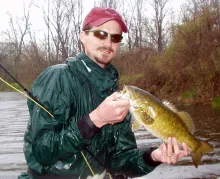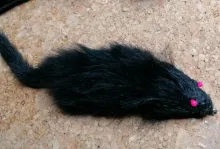Two tails are better than one says Mark Dysinger, who is an avid pike angler. In this, his latest pattern, he has created a large and very lively fly for the mossy green predator of the lakes. And it can tempt a bass too...
One of the
most important qualities that a successful pike fly must have is movement, and one of the best tying materials that generates movement in the water is rabbit. After experiencing some success with patterns that incorporate rabbit strips, I came to the conclusion that more rabbit might mean more pike. From this line of thought came the Bunny Split.
Scott Sanchez developed
a pattern called the Double Bunny that uses two rabbit strips for a tail. These strips are glued together by their hides, and I find that this unnecessarily impairs the mobility of the material in the water. In such a case, the only real movement is from the very tips of the strips and the individual hairs along their length. The Bunny split utilizes two magnum zonker strips for the tail, with flash material sandwiched between the two. The strips are not glued together, and thus are able to swing and wiggle independently of each other in the water. A wire loop guard helps to prevent tangling.
|
|
|
|
|
|
The collar is
composed of layers of marabou. Some pike patterns use cross-cut rabbit strips for a collar (i.e., Reynold's Pike Fly), but I prefer the fluid movement of marabou. It's also easier to alternate or blend colors with marabou than it is with cross-cut rabbit. As a bonus, the marabou does a nice job of hiding the wire loop guard. The collar is the most fragile component of the fly. The magnum zonker strips and epoxied head are quite rugged.
I make this
fly with bright color combinations, mixing and matching the top and bottom tail components and sometimes alternating the marabou layer colors for the collar. Colors such as white, yellow, and chartreuse are good starting points, and accents of red are always a nice touch. Although muted colors such as olive, brown, and black have their place, I have yet to use them very much with this pattern simply because the brighter colors have been so effective.
Fishing this fly
requires a heavy rod. The zonker strips and epoxied head create bulk, requiring a weight forward line and stout leader for turnover on the cast. I fish this fly with a ten weight outfit and usually use a floating weight forward line. Once sufficiently wet, the fly will sink at a slow rate. This makes it fine for shallow waters, but for water depths over five or six feet a sink tip or intermediate line should be used, especially if the fish are holding near bottom.
There are two
approaches to retrieving this fly, and I have found success with both depending upon conditions. When the fish are fairly active, a single hand strip retrieve is best. Let the activity level of the fish dictate how long and fast each strip should be, and how long you should pause between strips to let the fly sink a bit. When the fish are less active or just plain neutral, a slow two handed retrieve can trigger strikes by steadily pulling the fly through the water just fast enough to make the rabbit hairs and strips shimmy.
Although I tie
this fly with pike in mind, I have also caught several nice largemouth and smallmouth bass while fishing it. I have plans this year to test it in the salt, where I believe the bluefish and perhaps even striped bass will give chase.
- Log in to post comments






















I use the wire
I use the wre wrapped type of guitar strings (nylon might work too) as my guard loop to prevent tail tangles. It's springy, yet strong and won't collapse..